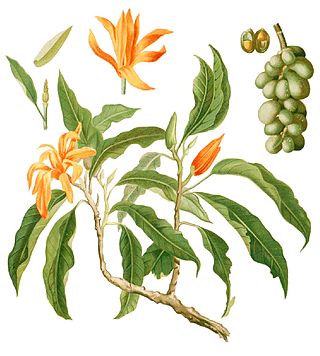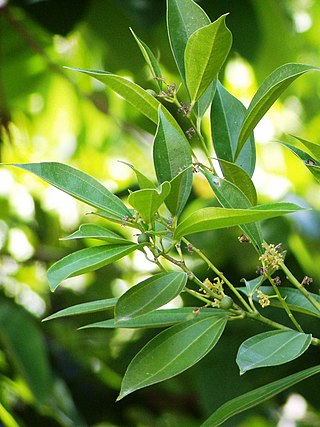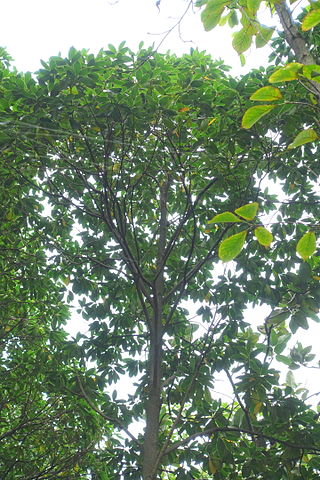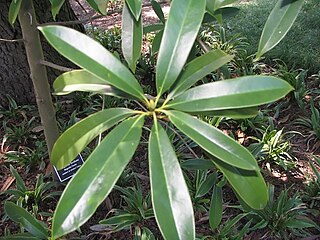
Ficus benjamina, commonly known as weeping fig, benjamin fig or ficus tree, and often sold in stores as just ficus, is a species of flowering plant in the family Moraceae, native to Asia and Australia. It is the official tree of Bangkok. The species is also naturalized in the West Indies and in the states of Florida and Arizona in the United States. Its small fruit are favored by some birds. Ficus tree has shown to have environmental benefits in urban areas like being a biomonitor. The plant also has allergens associated with it.

Magnolia wilsonii, or Wilson's magnolia, is a species of Magnolia native to China, in the provinces of western Guizhou, Sichuan and northern Yunnan, where it grows in the forest understory at altitudes of 1,900-3,000 m, rarely up to 3,300 m.

Magnolia delavayi is a species of flowering plant in the genus Magnolia. It is known by the common names of Chinese evergreen magnolia or Delavay's magnolia. It was named after Father Delavay, French Catholic missionary in China, who collected it.

Magnolia champaca, known in English as champak, is a large evergreen tree in the family Magnoliaceae. It was previously classified as Michelia champaca. It is known for its fragrant flowers, and its timber used in woodworking.

Nuphar lutea, the yellow water-lily, brandy-bottle, or spadderdock, is an aquatic plant of the family Nymphaeaceae, native to northern temperate and some subtropical regions of Europe, northwest Africa, and western Asia. This species was used as a food source and in medicinal practices from prehistoric times with potential research and medical applications going forward.

Nymphaea mexicana is a species of aquatic plant that is native to the Southern United States and Mexico as far south as Michoacán. Common names include yellow water lily, Mexican water lily and banana water lily.

Aglaia edulis is a tree species of plant in the family Meliaceae. It occurs in Tropical Asia from India to Yunnan and South-Central China. The wood and timber are used for various purposes.

Thismia is a genus of myco-heterotrophic plants in family Burmanniaceae, first described as a genus in 1845. It is native to East and Southeast Asia, New Guinea, Australia, New Zealand, and the Americas.

Pachygone laurifolia, the laurel-leaved snail tree, is a medium-sized, shrubby evergreen tree of the moonseed family, Menispermaceae. It is native to the foothills of the Himalaya Mountains, China, Taiwan, and Japan, where it commonly grows to a height of 25 ft, with an equal spread. In cultivation it can reach a similar size where conditions are favorable. Form is round-headed, with a medium to fast growth rate and a coarse texture. Leaves are ovate-lanceolate, about 6" long by 2" wide, with a spiral bud arrangement. Leaf color is medium green. This species is dioecious, with male and female flowers on separate plants. Flowers are insignificant: small, yellowish and appearing in spikes at leaf axils. Fruit is a small black drupe. With frequent shearing, plants may work well in a formal setting as a hedge or screen. Will take a wide range of sun and soil conditions within its temperature tolerance.

Phalaenopsis subg. Ornithochilus is a subgenus of the genus Phalaenopsis native to Southeast Asia and the Indian Himalayas.

The flora of China consists of a diverse range of plant species including over 39,000 vascular plants, 27,000 species of fungi and 3000 species of bryophytes. More than 30,000 plant species are native to China, representing nearly one-eighth of the world's total plant species, including thousands found nowhere else on Earth. China's land, extending over 9.6 million km, contains a variety of ecosystems and climates for plants to grow in. Some of the main climates include shores, tropical and subtropical forests, deserts, elevated plateaus and mountains. The events of the continental drift and early Paleozoic Caledonian movement also play a part in creating climatic and geographical diversity resulting in high levels of endemic vascular flora. These landscapes provide different ecosystems and climates for plants to grow in, creating a wide variety of different flora spanning over not just China, but different parts of the world.

Euryale is a genus of flowering plants of the family Nymphaeaceae.

Magnolia liliifera, commonly known as egg magnolia, is a flowering tree native to the Indomalayan realm. It bears white to cream-colored flowers on terminal stems. The leaves are elliptical and get as large as 25 cm (10 in) long and 8 cm (3 in) wide. The tree ranges in height from 3.5 to 18.5 m in situ.

Celtis philippensis, is an Asian species of flowering plant in the family Cannabaceae. It is a tree which can grow up to 30 meters tall. It ranges from India and Sri Lanka to southern China and Taiwan, the Philippines, New Guinea and the Solomon Islands, and northern Australia.

Magnolia lotungensis, the eastern joy lotus tree, is a species of flowering plant in the family Magnoliaceae, native to southern China, including Hainan. An androdioecious, hexaploid evergreen tree reaching 30 m (98 ft), it is typically found in forests from 700 to 1,400 m above sea level. It is used as a street tree in a number of southern Chinese cities. Due to its strength, easy maintenance, narrow growth habit with a rounded crown, and cold hardiness, it is showing promise as an ornamental tree in North America and Europe.

Schima superba is a species of flowering plant in the tea family Theaceae, native to subtropical areas of Vietnam, southern China, Hainan, Taiwan, and the Ryukyu Islands. With Pinus massoniana it often dominates forests from 100 to 800 m in elevation. It is used as a street tree in a number of southern Chinese cities.

Thevetia ahouai is a species of flowering plant in the family Apocynaceae, native to Mexico, Central America, Cuba, Colombia, and Venezuela, and introduced to southeastern China. An evergreen shrub or small tree of forests reaching 3 m (10 ft), it is used as a street tree in Nicaragua and Colombia.

Magnolia maudiae, the smiling monkey forest tree, is a species of flowering plant in the family Magnoliaceae. It is native to southern China, including Hainan. A shrubby tree occasionally reaching 20 m (66 ft) in the wild, it is found growing in evergreen broadleaf forests from 600 to 1,500 m above sea level. A well-shaped evergreen species, it blooms early with heavily fragrant white flowers, and has attractive bluish-green leaves. It is used as a street tree in southern Chinese cities.

Magnolia fordiana is a widespread species of flowering plant in the family Magnoliaceae, native to southern China, Hainan, and Vietnam. An evergreen tree reaching 25 m (82 ft) tall, it is found in hilly forests, often beside rivers, at elevations from 300 to 1,200 m. Specialists in Magnolia believe that most Magnolia fordiana specimens offered for sale are actually the closely related Magnolia yuyuanensis, a more attractive tree and one that is better adapted to cultivation. It is widely used as a street tree in southern Chinese cities.

Magnolia floribunda is a species of flowering plant in the family Magnoliaceae, native to southern China, Myanmar, Thailand, Laos, and Vietnam. A tree reaching 20 m (66 ft) tall, it is found in forests at elevations from 1,300 to 2,700 m. It is used as a street tree in a number of Chinese and Australian cities.





















